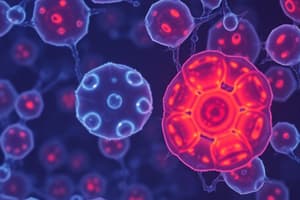Podcast
Questions and Answers
Which of the following is a common feature shared by prokaryotes and eukaryotes?
Which of the following is a common feature shared by prokaryotes and eukaryotes?
- Membrane bound organelles
- DNA in the form of a double stranded helix (correct)
- Nomarski (DIC) optics
- Living, dividing cells
What is the benefit of using Nomarski (DIC) optics?
What is the benefit of using Nomarski (DIC) optics?
- Better contrast and a more 3D image (correct)
- DNA in the form of a double stranded helix
- Membrane bound organelles
- Higher resolution
How do prokaryotes differ from eukaryotes?
How do prokaryotes differ from eukaryotes?
- They have DNA in the form of a double stranded helix
- They contain no membrane bound organelles (correct)
- They are made out of living, dividing cells
- They use Nomarski (DIC) optics
What is the main advantage of electron microscopy over regular light microscopy?
What is the main advantage of electron microscopy over regular light microscopy?
Which of the following is NOT made out of living, dividing cells?
Which of the following is NOT made out of living, dividing cells?
Flashcards are hidden until you start studying
Study Notes
Common Features of Prokaryotes and Eukaryotes
- Both prokaryotes and eukaryotes possess a cell membrane surrounding their cells.
- Genetic information is housed in DNA, which serves as the blueprint for protein synthesis in both types of cells.
- Ribosomes are present in both, facilitating the process of protein synthesis.
Benefits of Nomarski (DIC) Optics
- Nomarski differential interference contrast (DIC) microscopy enhances contrast in transparent samples, making cellular structures more visible.
- Provides a three-dimensional appearance to specimens, allowing for better visualization of morphology and internal details.
- Useful in observing live cells without staining, preserving their natural state.
Differences Between Prokaryotes and Eukaryotes
- Prokaryotes lack a membrane-bound nucleus, while eukaryotes have a defined nucleus containing their DNA.
- Prokaryotic cells are generally smaller and simpler in structure compared to eukaryotic cells.
- Eukaryotes possess membrane-bound organelles (like mitochondria and endoplasmic reticulum), absent in prokaryotes.
Advantages of Electron Microscopy Over Light Microscopy
- Electron microscopy offers significantly higher resolution, allowing observation of structures at the nanometer scale.
- Capable of providing detailed images of cellular organelles and surface structures that cannot be seen with light microscopy.
- Utilizes electron beams instead of light, enabling visualization of fine details beyond the limits of optical microscopy.
Non-Living, Non-Dividing Entities
- Viruses are NOT made of living, dividing cells; they require a host cell to replicate.
- Prions, made up of misfolded proteins, also do not constitute living cells and lack cellular structure.
- Components like dead plant materials or synthesized polymers do not fall under the category of living dividing cells.
Studying That Suits You
Use AI to generate personalized quizzes and flashcards to suit your learning preferences.




